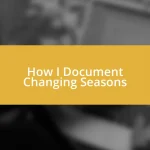Key takeaways:
- Street photography captures candid moments and relies on anticipation, composition, and the ability to blend into the environment.
- Developing a unique style involves reflecting on influences, experimenting with techniques, and engaging with subjects to create a personal narrative.
- Ethical considerations, legal awareness, and thoughtful post-processing are essential aspects that enhance storytelling and respect for subjects in street photography.

Understanding Street Photography Basics
Street photography is all about capturing the candid moments of daily life. I remember a chilly morning when I spotted an elderly man feeding pigeons in the park. The way he smiled as he tossed breadcrumbs made me realize how these fleeting moments can tell powerful stories—stories that often go unnoticed.
Understanding the basics of street photography means learning to blend observation with anticipation. It’s not just about having a good camera; it’s about being in the right place at the right time. Have you ever felt that rush when you click the shutter just as a unique moment unfolds? That’s the essence of street photography—a spontaneous dance between you and your environment.
Composition can also play a significant role in this genre. I often experiment with leading lines or the rule of thirds to draw the viewer’s eye into the frame. Once, I shot a bustling sidewalk scene, using a nearby tree to frame the action. The layered visuals created depth that really brought the chaos of the city life into focus. How do you think composition influences the story you’re trying to tell?

Developing a Unique Style
Developing a unique style in street photography is a journey that reflects your personality and experiences. I often find that my style evolves as I immerse myself in different environments. For instance, during a recent trip to a vibrant market, I focused on capturing not just the subjects but also the colors, sounds, and smells, which shaped my narrative. This immersive approach deepens the connection between the viewer and the story I’m telling.
To help you on your journey, consider these strategies for honing your unique style:
- Be Mindful of Your Influences: Reflect on photographers who inspire you and think about what resonates with you in their work.
- Experiment with Different Techniques: Try shooting at varying times of day or from unusual angles to see what feels authentic.
- Engage with Your Subjects: Sometimes, starting a brief conversation can create a more genuine connection and reveal their personality in your shots.
- Incubate Your Ideas: Don’t rush! Let your experiences simmer in your mind, allowing your distinct vision to emerge naturally over time.
- Create a Signature: Develop a visual signature—perhaps a recurring theme or color palette that creates cohesion in your body of work.
Each of these strategies can help you to peel back the layers and reveal your voice in the bustling world of street photography. It’s about capturing what you care for and sharing it with others in a way that feels uniquely yours.

Choosing the Right Equipment
Choosing the right equipment for street photography is crucial, as it can make a significant difference in your ability to capture those spontaneous moments. I personally prefer lightweight cameras, like mirrorless options, because they allow for quick and discreet shooting. On a recent outing, I found myself in a crowded urban setting, and having a compact camera enabled me to blend into the scene rather than becoming a focal point. Wouldn’t you agree that being unobtrusive can often yield the most genuine expressions?
When it comes to lenses, I always opt for prime lenses with wide apertures. My go-to is a 35mm f/1.8 lens. It strikes a perfect balance between capturing a wide perspective and isolating subjects in low light. I recall one instance when I was at a dusk street fair; the ambient light was fading fast, but my lens allowed me to capture vibrant colors without using flash. Honestly, choosing the right lens can transform the entire mood of your images.
Lastly, don’t underestimate the importance of accessories. A sturdy strap can help prevent drops during unpredictable moments, and a small external flash can be handy for bouncing light off surfaces. I once had a situation where an unexpected rain shower hit, and my camera had to withstand the elements. Fortunately, my weather-sealed gear held up beautifully, allowing me to continue shooting despite the drizzle. Each piece of equipment I choose is intentional, aimed at enhancing my experience and capturing the beauty around me.
| Equipment | Pros |
|---|---|
| Mirrorless Camera | Lightweight and unobtrusive |
| 35mm f/1.8 Lens | Great in low light; versatile focal length |
| External Flash | Enhances lighting without harsh effects |
| Sturdy Strap | Prevents drops during action |

Mastering Composition Techniques
Mastering composition in street photography is an exhilarating challenge that requires both skill and intuition. I often think about the rule of thirds; it’s one of those foundational techniques that can dramatically alter the narrative of a photo. When I’m framing a shot, I visualize a grid on the scene; placing my subject off-center creates more tension and interest. Have you ever noticed how a well-composed photo draws your eye to the action? It’s like inviting viewers into a part of the scene they might have overlooked.
Another composition technique I emphasize is leading lines; they guide the viewer’s gaze and create a sense of depth in the image. I remember a stroll through a winding alley where I spotted an intriguing shadow cast by a wrought-iron gate. By positioning my camera so that the lines of the pavement drew the eye toward the shadow, I transformed an ordinary moment into a captivating story. Isn’t it amazing how something as simple as a line can add such dimension to your photographs?
Finally, I can’t stress enough the importance of capturing candid moments. Designing a composition that feels natural can sometimes lead to the most authentic expressions. Last spring, while photographing a busker performing on the streets, I noticed a child mesmerized by the music. Instead of focusing solely on the performer, I included the child in my frame, capturing the pure joy on their face. This approach not only tells a richer story but also evokes emotion from those who view the photograph. Isn’t that what street photography is all about—connecting with real moments?

Capturing Emotion and Human Stories
Let’s dive into the intricacies of capturing emotion and human stories in street photography. There’s something incredibly powerful about freezing a fleeting moment that showcases genuine feelings. I particularly remember one sunny afternoon while exploring a local market. I stumbled upon an elderly couple holding hands, their faces alight with laughter as they shared a whispered joke. There’s no greater joy than seizing that raw interaction and transforming it into an everlasting memory. It makes me wonder: how often do we overlook these beautiful exchanges happening all around us?
In my experience, the key to connecting with your subjects lies in being present and attentive. On one occasion, while wandering through a bustling street filled with artists, I noticed a painter intensely focused on her canvas, her brow furrowed in concentration. I captured that moment, and it resonated deeply with viewers. They could sense her passion and dedication. Isn’t it fascinating how a single photograph can tell a story of perseverance and creativity? Each snapshot presents an opportunity for us to convey emotions that words sometimes fail to express.
Human stories often unfold in the tiniest of gestures, like a smile exchanged between strangers or a moment of indecision before making a choice. I recall capturing a young woman waiting for a bus, her expression a mix of hope and uncertainty. That candid moment spoke to many who saw it, provoking questions about life’s unpredictability. When I share these images, it’s not just about the technical details; it’s about inviting viewers into the narrative. How do you feel when you look at an image that connects with your own experience? Each photograph can spark introspection and conversation, bridging connections among us.

Navigating Legal and Ethical Considerations
When it comes to street photography, understanding the legal landscape is vital. There have been instances where I’ve felt the tension of photographing someone in a public space, only to realize later that they might have felt uncomfortable. It’s a delicate balance—while we often have the right to shoot in public areas, it’s essential to be aware of privacy and the potential impact of our actions on strangers’ lives. Have you ever considered how your presence can alter someone’s experience?
Ethically, I believe it’s crucial to approach photography with respect and empathy. I remember a time when I encountered a street vendor selling handmade crafts. Instead of just snapping away, I introduced myself and asked if I could take some pictures. The warmth in her smile and willingness to engage added depth to the images I captured. Engaging with your subjects can transform a simple photo into a meaningful exchange. Isn’t it incredible how a small act of consideration can lead to enriching our storytelling?
Finally, considering how images might be used is equally important. I think back to a powerful shot I took of a protest, where the raw emotion was palpable. However, I hesitated to post it online, fearing it could be misrepresented or sensationalized. It reinforced for me the responsibility we have as photographers—not just to capture moments, but to represent them truthfully. How do you reconcile the urge to share compelling images with the potential consequences they might bear? It’s a thought-provoking challenge that informs my approach to ethical photography every day.

Post-Processing Methods for Enhancement
Post-processing is where I really like to refine my street photography. For me, it’s almost like adding the final brushstrokes to a painting. Sometimes, I’ll spend hours adjusting contrast and saturation. I recall an image from a rainy day in the city. After tweaking the colors and enhancing the shadows, the droplets on the pavement glistened, creating a moody atmosphere that transformed the entire feel of the photograph. Isn’t it amazing how small adjustments can breathe new life into an image?
When I think about sharpening and cropping, I cannot help but reflect on a striking moment I captured during a street festival. After reviewing the shot, I realized the subject—a child joyfully spinning with a toy—was slightly off-center. Cropping it to bring the child into focus not only eliminated distractions but also heightened the emotional intensity. How do you decide what to keep or remove? My gut usually tells me what feels right in terms of composition.
I also enjoy exploring various editing software tools to enhance my images further. Recently, I experimented with a popular app that allows for selective color adjustments. I applied it to a shot featuring a street musician, bringing his bright instrument to life while keeping the background muted. It turned what could have been just another busy street scene into a vibrant focal point that captured my subject’s passion. Have you ever thought about how to make your subjects stand out in a crowded frame? Discovering these post-processing techniques has been like unlocking new creative doors for me, and I can’t wait to see what more I can learn.














